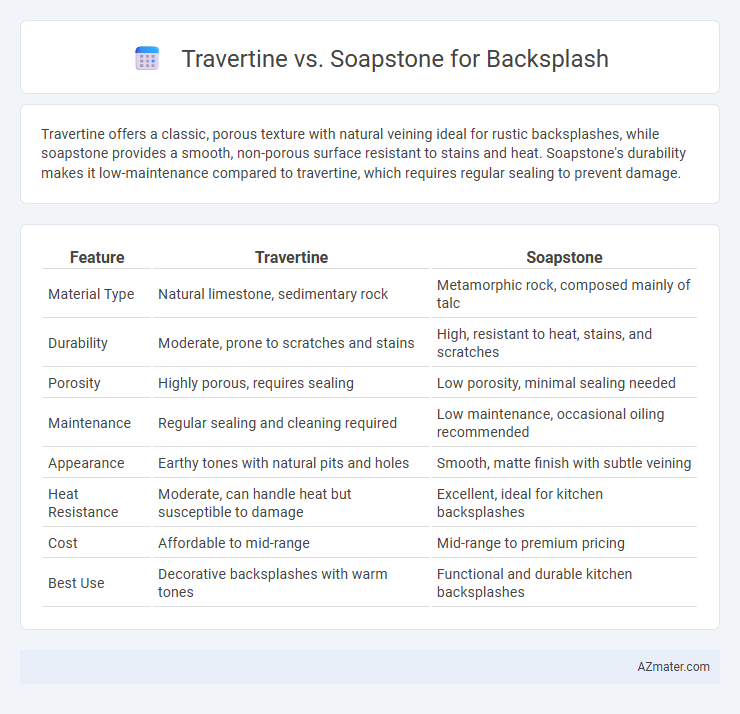Travertine offers a classic, porous texture with natural veining ideal for rustic backsplashes, while soapstone provides a smooth, non-porous surface resistant to stains and heat. Soapstone's durability makes it low-maintenance compared to travertine, which requires regular sealing to prevent damage.
Table of Comparison
| Feature | Travertine | Soapstone |
|---|---|---|
| Material Type | Natural limestone, sedimentary rock | Metamorphic rock, composed mainly of talc |
| Durability | Moderate, prone to scratches and stains | High, resistant to heat, stains, and scratches |
| Porosity | Highly porous, requires sealing | Low porosity, minimal sealing needed |
| Maintenance | Regular sealing and cleaning required | Low maintenance, occasional oiling recommended |
| Appearance | Earthy tones with natural pits and holes | Smooth, matte finish with subtle veining |
| Heat Resistance | Moderate, can handle heat but susceptible to damage | Excellent, ideal for kitchen backsplashes |
| Cost | Affordable to mid-range | Mid-range to premium pricing |
| Best Use | Decorative backsplashes with warm tones | Functional and durable kitchen backsplashes |
Introduction to Travertine and Soapstone
Travertine is a natural stone formed from calcium carbonate deposits, known for its porous texture and warm, earthy tones that add a rustic charm to backsplashes. Soapstone, composed primarily of talc and magnesium silicate, offers a smooth, non-porous surface with excellent resistance to heat and stains, making it highly durable for kitchen applications. Both materials provide unique aesthetic and functional benefits, with travertine's veining and soapstone's matte finish catering to different design preferences.
Material Overview: Travertine vs Soapstone
Travertine is a natural limestone characterized by its porous texture and warm beige tones, offering a classic, rustic appearance ideal for backsplashes with traditional or Mediterranean designs. Soapstone, a metamorphic rock rich in talc, is denser and smoother with a matte finish and naturally dark grey hues that develop a patina over time, making it highly resistant to heat and stains. While travertine requires sealing to prevent moisture absorption, soapstone's low porosity ensures easier maintenance and superior durability for kitchen backsplashes.
Aesthetic Appeal and Design Versatility
Travertine offers a warm, earthy aesthetic with its natural pitted texture and rich beige tones, making it ideal for rustic or Mediterranean-style backsplashes. Soapstone provides a smooth, matte finish with deep charcoal hues that lend a sleek, modern appeal, perfect for contemporary or minimalist kitchen designs. Both materials offer versatile design options but differ significantly in visual impact, with travertine enhancing organic warmth and soapstone emphasizing understated elegance.
Durability and Longevity Comparison
Travertine offers moderate durability with a porous surface that requires regular sealing to prevent staining and etching, making it less ideal for high-moisture kitchen backsplashes. Soapstone exhibits superior longevity due to its dense, non-porous nature, naturally resisting heat, stains, and bacterial growth without the need for sealing. When comparing durability, soapstone outperforms travertine by maintaining its appearance and structural integrity over time under typical kitchen conditions.
Maintenance Requirements
Travertine backsplashes require regular sealing to prevent staining and moisture damage due to their porous surface, making maintenance more intensive over time. Soapstone, known for its non-porous nature and resistance to staining, only needs occasional oiling to maintain its dark patina and prevent dryness. Both materials demand specific care, but soapstone generally offers lower upkeep and better durability in wet kitchen environments.
Stain and Heat Resistance
Travertine backsplashes exhibit moderate stain resistance but require sealing to protect against oil and acidic spills, while soapstone offers superior stain resistance due to its non-porous surface. Soapstone also boasts excellent heat resistance, tolerating high temperatures without damage, making it ideal for kitchen backsplashes near stovetops. Travertine is heat resistant but can be more vulnerable to cracking or discoloration from extreme heat exposure compared to the durable, dense structure of soapstone.
Cost and Installation Factors
Travertine backsplash costs typically range from $10 to $30 per square foot, with installation expenses around $15 to $25 per square foot due to its porous nature requiring sealing and precise cutting. Soapstone is more expensive, averaging $30 to $50 per square foot, but its dense, non-porous surface simplifies installation and reduces maintenance costs over time. Installation of soapstone is generally less labor-intensive compared to travertine, making it a preferred choice for durability despite the higher material cost.
Eco-Friendliness and Sustainability
Travertine and soapstone both offer eco-friendly options for backsplashes, with travertine being a natural sedimentary limestone known for its abundant availability and low-energy quarrying processes. Soapstone excels in sustainability due to its durability and resistance to stains, reducing the need for chemical sealants or frequent replacements. Choosing soapstone or travertine supports environmentally responsible design by providing long-lasting materials with minimal environmental impact.
Popular Styles and Trends
Travertine backsplashes showcase natural, porous textures with warm beige, cream, and honey hues, aligning with popular rustic and Mediterranean kitchen styles. Soapstone offers smooth, matte surfaces in deep charcoal and soft gray tones, favored in modern and farmhouse trends for its durability and unique veining. Current design preferences highlight travertine's vintage charm and soapstone's sleek, timeless appeal for versatile backsplash aesthetics.
Which Backsplash Material is Right for You?
Travertine backsplashes offer natural durability and a warm, rustic appearance ideal for kitchens seeking a classic, textured look, while soapstone provides a smooth, non-porous surface resistant to stains and heat, perfect for low-maintenance, modern designs. Consider travertine if you prefer a porous stone that develops a unique patina over time, and soapstone if you want a sleek, dark surface that resists scratches and bacteria. Your choice depends on balancing aesthetic preferences with practical needs such as maintenance, durability, and kitchen style.

Infographic: Travertine vs Soapstone for Backsplash
 azmater.com
azmater.com